Mailchimp vs ConvertKit: Which platform fits your community’s needs?

Why are email marketing platforms important for community managers?
Before getting into the nitty-gritty, it’s important to understand why email platforms are crucial for online communities.
For community managers, email tools offer more than just sending a newsletter every now and then. An email platform provides a direct line to your members, helping you with your community engagement and retention.
With the right tools, you can:
Personalise outreach with segment-specific content. Sending tailored messages to new/active/dormant members is crucial to overall community engagement rates.
Automate emails and workflows to help community managers onboard members, send follow-ups, or provide resources without manual effort.
Integrate with other tools like community forums, social media, and CRM platforms will help community managers to streamline their operations.
Scale! As your community grows, you want to ensure your chosen email platform can scale with it.
This guide compares ConvertKit and Mailchimp, focusing on the features that matter most to community managers. Let’s see how the two platforms stack up against each other!
A snapshot of ConvertKit
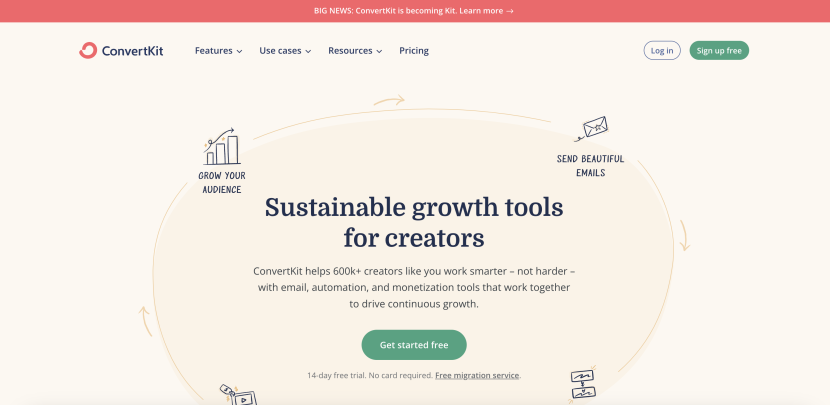
ConvertKit is an email marketing platform built with creators and ‘solopreneurs’ in mind. ConvertKit is commonly used by artists, bloggers, coaches, course creators, podcasters, and YouTubers, to name a few.
ConvertKit breaks its features down into five key areas:
Grow: Helping you grow your audience and channel reach
Send: Easily create and send email sequences with audience segmentation
Automate: Save time with an automation builder
Monetise: Sell digital products and integrate with your sales dashboard
Learn: Access a content library, online community, and ‘University’ so you can grow, learn, support, and get advice from other creators.
A snapshot of Mailchimp
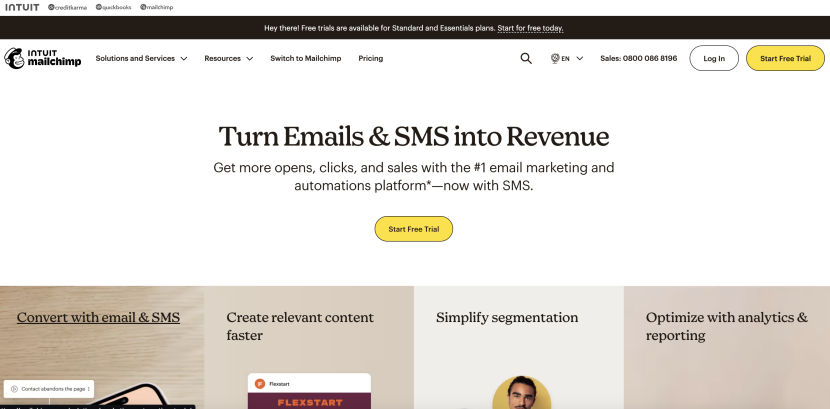
Mailchimp is one of the most popular and established email marketing platforms, with 40.47% of the market share. As such, Mailchimp has a vast user base and is widely trusted by many businesses.
Mailchimp is known for its:
Versatile design tools
Drag-and-drop editor
100+ customisable templates
Extensive integration options (over 250 apps!) A
Comparing ConvertKit and Mailchimp at a glance
Feature | ConvertKit | Mailchimp |
Free plan | Free up to 10,000 subscribers, with unlimited emails. | Free up to 500 subscribers, with 1,000 monthly emails. |
Paid plans |
|
|
Free trial | Yes, 14-day trial and no card required | Yes, one month trial and card is required |
Ease of use |
|
|
Automation | Advanced workflows and easy-to-use visual builder | Basic automations but advanced features available in paid plans |
Community engagement | Focus on personalised communication, with flexible tagging options | Great for list management, and multiple audience groups |
Analytics and reporting | Basic reports: email opens, clicks, unsubscribes etc | Advanced analytics, including predictive insights and behaviour tracking |
Best for | Small communities, content creators, coaches | Larger communities, data-driven marketing, advanced segmentation |
Automation
Automating tasks—such as onboarding new members, sending reminders, or delivering targeted content—is crucial for community managers so you don’t lose that personal touch with your members. Automation can also save you a lot of time.
Let’s see how both platforms handle automation:
ConvertKit
Visual automation builder
ConvertKit allows community managers to create complex and customisable workflows triggered by user behaviours like signing up, attending events, or clicking on a particular link.
For example, one of ConvertKit’s pre-made automations is ‘Segment your audience’ with the following steps:
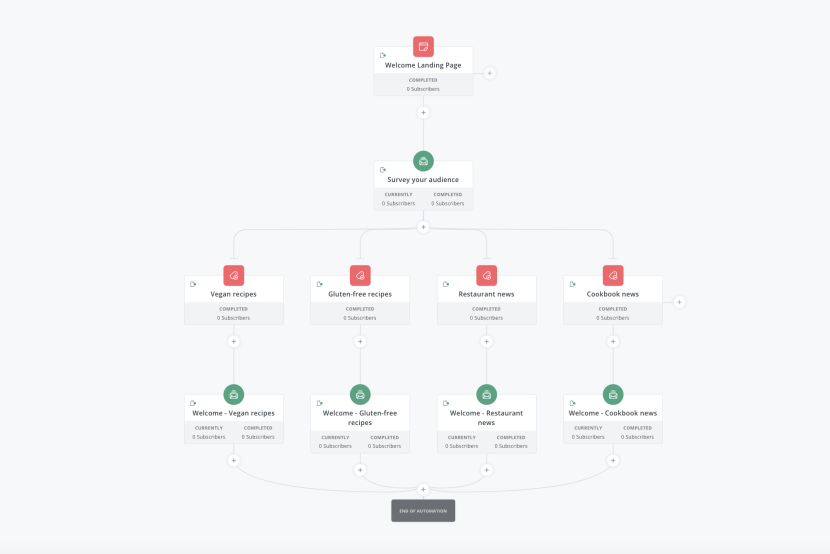
This is clean, simple, and ready to implement for any community manager looking to personalise communication with their members.
Condition triggers
ConvertKit also offers an ‘if this, then that’ logic for more advanced and customised automation.
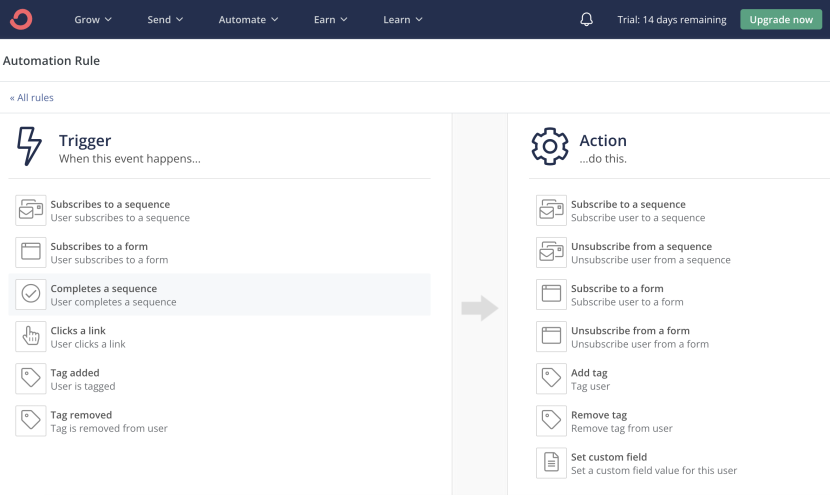
Pros:
Highly customisable
No cap on the number of steps in an automation sequence
Easy to set up
Cons:
Limited to one visual automation and one email sequence on the free plan
Lacks variation of templates compared to Mailchimp
Mailchimp
Pre-built automations
Mailchimp offers out-of-the-box workflows for everyday tasks, like welcome emails and re-engagement campaigns. Some of Mailchimp’s pre-built customer journeys also include AI-powered automation.
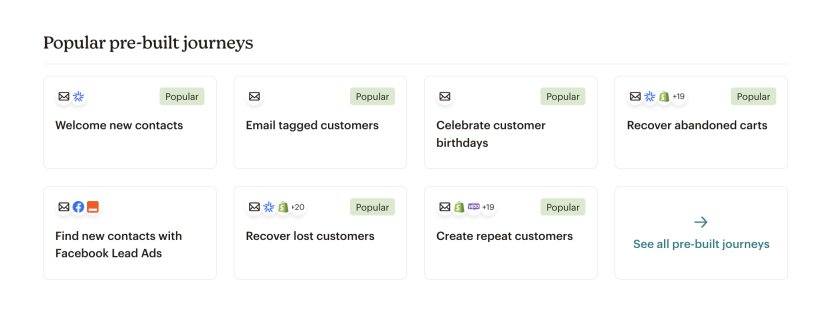
Advanced automation in higher tiers
Features like multi-step sequences and customised triggers are available, but they only feature in Mailchimp's paid plans.
Pros:
Wide range of triggers
Perfect for bigger community segments
Cons:
Limited in free and basic plans (only four ‘journey points’ available in the Essentials plan)
Less customisable than ConvertKit
Not as intuitive as ConvertKit’s visual builder
What platform suits your community sector?
The type of community you’re building will also influence which email tool suits you better. Let’s look at four popular community types—e-commerce, content-focused, large-scale memberships, and educational communities.
Quick answer: Mailchimp for e-commerce communities
Mailchimp is ideal for product-based communities that need to scale and drive sales through email marketing.
Mailchimp key features:
Product recommendations in emails
Abandoned cart recovery emails
Advanced analytics
Integrations with popular e-commerce sites, including Shopify, Wix, and WooCommerce
Quick answer: ConvertKit for content-driven communities
Online communities focused on coaching or digital products, for example, rely on personalised communication to maintain close connections with their audience. Community managers, therefore, need flexible automations that allow them to engage members based on specific actions.
ConvertKit key features:
Organise audience with flexible tagging
Simple interface to focus on content
Personalise communication without heavy design requirements
Quick answer: Mailchimp for large-scale membership communities
Mailchimp is best for large-scale membership communities that need mult-list management and extensive reporting.
Mailchimp key features:
Segment members into different groups based on behaviour and demographics
Detailed reporting on member engagement, including customer lifetime value*
AI tools to forecast member actions and optimise email campaigns accordingly
*The ’customer lifetime value’ feature is only available for Standard or Premium plans.
Quick answer: ConvertKit for educational/training communities
ConvertKit is an excellent fit for educational communities that need to send automated sequences. Its straightforward automation allows community managers to easily deliver content over time, helping you to guide members through relevant learning paths.
ConvertKit key features:
Build email sequences for course updates, lesson plans, reminders etc
Use tags to personalise communication based on user progress or activity
Free plan has a high subscriber count, making it accessible to many educational groups
Gathering feedback
Part of creating a successful online community is ensuring your members feel heard and valued. Gathering feedback and member data helps you adapt to their needs and ensure their long-term participation in the community.
Both Mailchimp and ConvertKit provide ways to support this objective:
Member feedback collection via Mailchimp
Mailchimp allows community managers to collect feedback through embedded surveys and polls with custom branding.
Here are some of Mailchimp’s templated survey options:
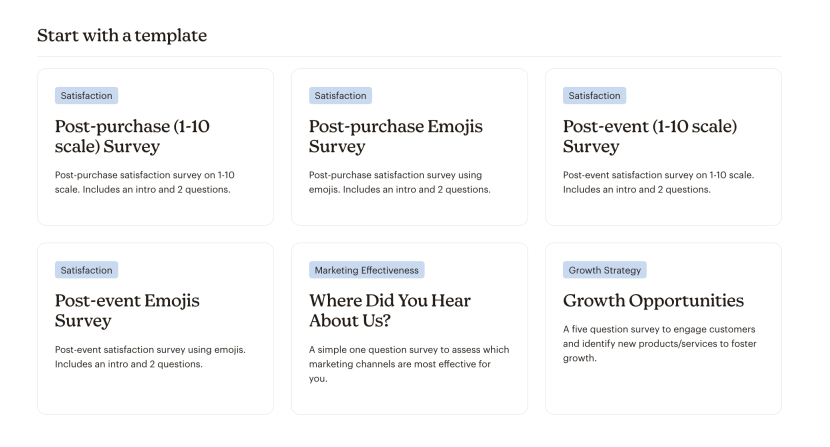
You can also integrate with the likes of Google Forms or SurveyMonkey to expand on feedback gathering.
Mailchimp’s advanced segmentation lets you group members based on their responses and adjust your strategies to suit them. This could be very useful for community managers who want to create a follow-up email series depending on feedback and provide members with niche solutions that correlate with their responses.
How to collect feedback using ConvertKit
ConvertKit makes feedback collection easy with its tagging and link trigger system.
Instead of traditional surveys, you can include clickable links corresponding to different interests or preferences. When subscribers click a link, they'll be automatically tagged based on their selection.
ConvertKit already has an automation sequence called ‘Let your subscribers self-segment based on their interests’ that you can customise to suit your community members:
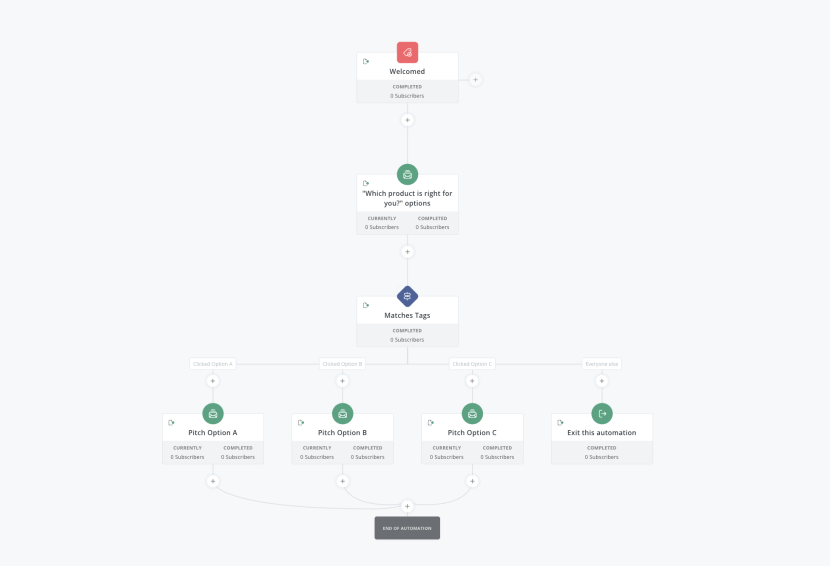
For example, if you run a pet care community, you might ask members to select their pet type—dog, cat, rabbit, or other. This will allow you to segment your subscribers based on their responses and send tailored content (like pet-specific care tips or product recommendations) to improve engagement and satisfaction with your email sequences.
ConvertKit also has several integrations available. Check out their integration page and filter by ‘Surveys & Quizzes’ to see more!
Support and learning resources
Remember, the email marketing tool you choose has to work for you as well as your members. As a community manager, having the proper support from your email marketing platform can make or break your campaigns, especially if you’re relatively new to email marketing.
Mailchimp's customer support
Support offered by Mailchimp is plan-dependent. For example, live chat support is not available on the free plan. To get phone support, you need to be on the Premium service (at a starting price of $350/month).
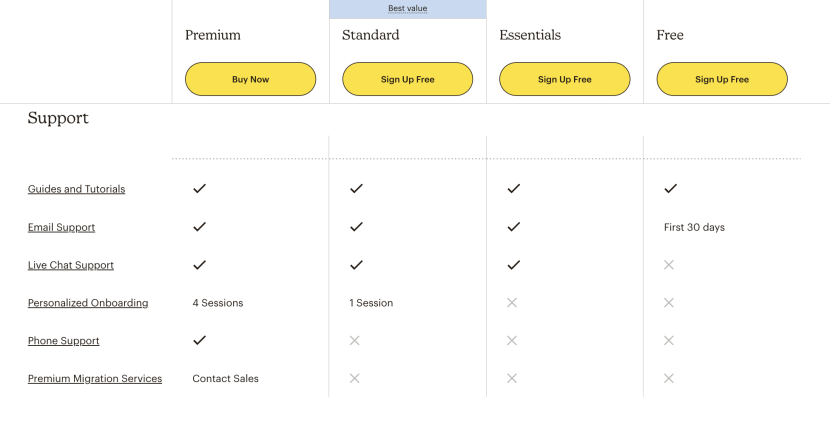
That’s why evaluating your support needs alongside your budget is essential before you choose your platform.
Mailchimp learning
What we can say about Mailchimp is its free resources are VAST.
From the Resources section of Mailchimp’s website, you’ll find:
Marketing library (covering e-commerce, digital content, marketing automation, audience management, website, email marketing, social media, and more!)
Help centre, including popular guides, video tutorials, and help by topic
Success stories
Upcoming events and on-demand webinars
If you’re managing a large community team with multiple admins, Mailchimp’s webinars, help centre, and forums can help you train new team members and stay updated with the latest email marketing trends.
ConvertKit's customer service
ConvertKit offers 24/7 support—whether you’re on the free plan or the Creator Pro plan. The only support difference between free and paid is you don’t get free migration on the free plan.
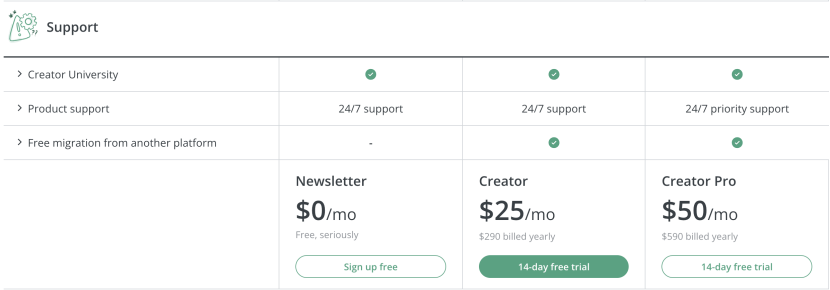
ConvertKit learning
ConvertKit’s knowledge base is more streamlined than Mailchimp’s, focusing mainly on creators growing their businesses and connecting with their audiences.
Key features:
Training in the form of tutorials and on-demand workshops
Creator University, with a ConvertKit crash course, newsletters for creators, and how to grow your business
Dedicated creator support (Creator Community) that allows users to network and engage with other creators
ConvertKit’s 24/7 support and creator-focused resources make it easier for new community managers to get up to speed and grow their audience quickly.
Platform costs
Of course, cost is one of the most significant deciding factors when choosing a platform.
Free plans
Both platforms offer a free plan, however, ConvertKit is more generous:
ConvertKit allows for 10,000 subscribers and includes unlimited emails
Mailchimp allows for 500 subscribers and 1,000 monthly emails
Mailchimp's paid plans
Mailchimp has three paid plans—Essentials, Standard, and Premium—with Essentials starting at a respectable £9.78 a month for 500 contacts.
The number of emails you can send per month depends on your contact limit (ranging from 500 to 50,000) and your plan:
Essentials plan: 10x the number of contacts
Standard plan: 12x the number of contacts
Premium plan: 15x the number of contacts
For more details on Mailchimp’s pricing plans, click here.
ConvertKit's paid plan
ConvertKit has two paid plans—Creator and Creator Pro—with Creator starting at $9 (approx £6.72) a month for 300 contacts.
ConvertKit has a simple pricing structure, with the price increasing on a sliding scale as contacts rise from 300 to 500,000.
There’s also a distinct list of features tied to each of the three plans, so you know exactly what you’re getting, regardless of how many contacts you have.
You can read more about ConvertKit’s pricing here.

Lists vs tagging
When thinking about controlling your costs, community managers should consider how these platforms handle subscribers.
ConvertKit is a ‘subscriber-centric’ platform—meaning all subscribers are added to one list and are defined by tagging and segmentation features. ConvertKit only counts a subscriber once, even if they’re tagged multiple times.
This differs from Mailchimp in that Mailchimp uses multiple lists to group subscribers together. Mailchimp then counts the same subscriber multiple times if they appear in different lists.
For example, a member-based online learning community for content creators will likely have members interested in multiple aspects of content creation, e.g. podcasting and video production.
With ConvertKit’s tagging method, the community manager can tag these members based on their specific interests (“podcasting course” and “video production course”), knowing that this member will only be counted once in the subscriber list.
This is essential for communities with overlapping interests to keep costs low. Members' interests may also expand during their time in your online community, and you don’t want to worry about unnecessarily inflating your subscriber numbers.
Choosing the right tools for your community platform
Ultimately, the right email marketing tools depend on your community’s size, focus, and goals. Both platforms have benefits and drawbacks, so weighing up what’s important for you and your subscribers is crucial.
Our verdict is ConvertKit is the better option for community managers of smaller communities who need flexible automation and personalised engagement strategies without being overwhelmed by countless designs, templates, and resources.
If you’re managing a data-driven community or require multiple segmentation options for different audience groups, Mailchimp may offer more value. Mailchimp is best suited for larger communities that need advanced design options and detailed analytics, but you’ll need to pay to access many of its features (predictive analysis, customer journey builders, phone support etc).
At Steadfast Collective, we build customer-first applications and websites. Whether you’re at the beginning of your online community journey or a seasoned community professional, we’re happy to jump in and help where we can. Let’s talk community!
More Articles

Can you track it?
Every budget is being put under the microscope right now, and quite right too.

When to Build Your Own Membership Platform (and When Not To)
I’ll let you in on a secret, not every membership organisation needs a bespoke membership platform.

Design for AWE
Anchor. Wonder. Connection. The blueprint for unforgettable memberships.

